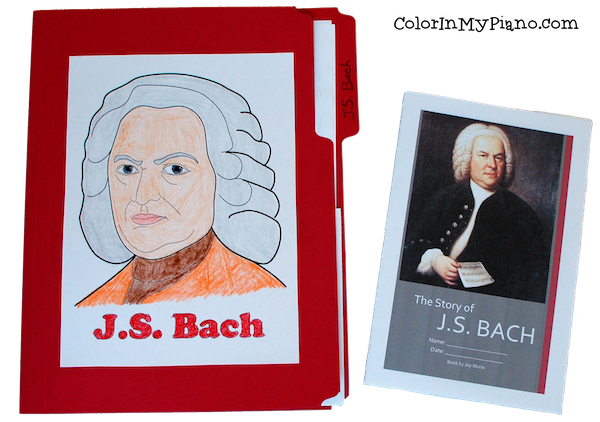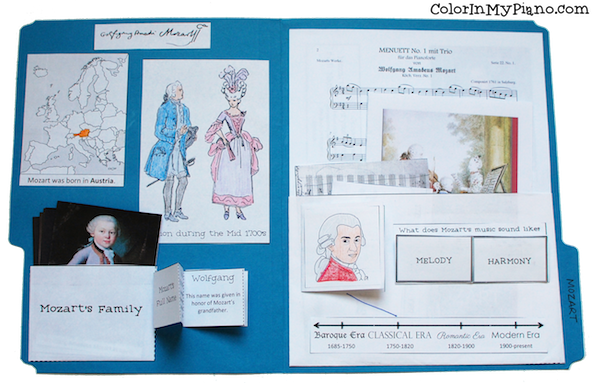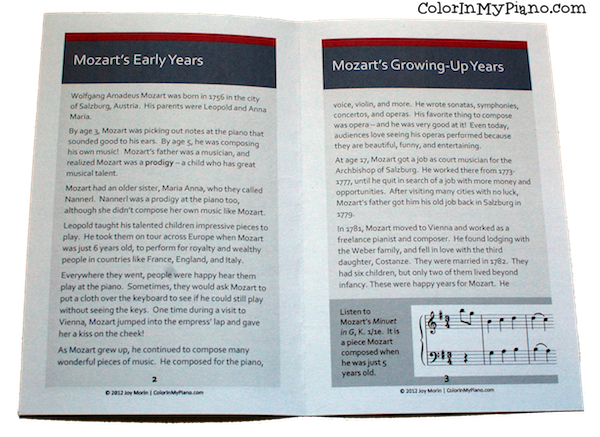Introducing the addition of a new series of resources to the Color In My Piano shop…
Remember the lapbooks that I blogged about from my recent music history camp? I finally have Bach and Mozart listed in the shop! I’ve been using these composer studies with my weekly homeschool music history class too.
Each composer study costs $10 and includes teacher pages, the biography booklet (picture above on the right), and the pages for assembling the lapbook. Here’s what the inside of the Mozart lapbook looks like: 
You can read the full details about each composer study on this page. More composers will be added in upcoming months.
As usual, I am so thankful for the kind support you have shown for Color In My Piano through comments/emails, and also for those of you who have shown support through the Color In My Piano shop. THANK YOU so much! I am always amazed at the kindness of others within our piano teaching community! As a token of thanks to you all, please enjoy downloading the biography booklet from the Mozart study for FREE:

This biography has been carefully researched to include all the important facts you would expect, yet is written in a way that is relevant and relatable for even your youngest students. To download, please visit the Printables > Lesson Plans page to download the Mozart biography (scroll down to the M’s). I hope you can find a way to use it with your students!
 Mozart Biography Booklet (365.8 KiB, 12,239 hits)
Mozart Biography Booklet (365.8 KiB, 12,239 hits)
GIVEAWAY: 3 winners will receive the rest of the Mozart composer study for free! To enter, just leave a comment below by midnight (EST) on Wednesday, September 26, 2012 with a tip or idea about incorporating music history into your students’ education.
PS: Special thanks goes to my sister, Susan, for drawing the composer coloring pages for me!




I have an idea about incorporating music history into my student’s music education, and that is to have a group class during the summer to discuss and explore composers. Each day of the class, a different music time period is explored with a few composers names taught and ONE specific composer who may best represent that period: Baroque…. Bach! Classical: Mozart! Romantic: Beethoven
I always have my students write up a page of information on the composers for each song they are studying. This usually results in them focusing on well known and some lesser-known composers and helps them understand their piece of music more thoroughly.
When a student is studying a specific piece, I ask them to find out as much as they can about that era or composer and come up with a list of “10 things they didn’t know about…” either specific to a period of music or a composer so they build up a sets of facts in a booklet which we can refer back to. They usually try to find the weirdest fact they can!
Right now with one of my students we are using the Meet the Great Composers books and they are perfect. There is a short, interesting bio about each composer in the book, and then a fun quiz on what we studied. I choose a composer from a song she is working on, and since it is short we have time to do it during the lesson.
I love incorporating music history into my lessons. It’s something that my childhood lessons were lacking.
Make it relevant to the time period they are currently studying in their history class at the time if at all possible!
Wow, I’m doing a composer unit study with my older students this semester, and just looking at your lapbook ideas is inspiring! I would absolutely love to win this giveaway!
Fun stuff Joy! Lap books make for a great group or camp activity. Speaking of which, that is my favorite way to learn about music history; in a group setting. I’ve used many resources over the years and when they are combined with fun hands on activities, even better!
I haven’t intentionally incorporated much history into my student’s education other worksheets on the composer or about a certain piece they are playing (and that had been rare too). Your lap book idea is sparking some ideas though!
LESSON: I think a bit of history can be incorporated into all parts of the lesson. Let’s say, maybe something from each musical period can be used in each component. If we are improvising, one week I can try using terraced dynamics from Baroque and explain it. For technique, perhaps use a key they are practising triads on and get them to create an alberti bass from the Classical period. Then we can introduce a piece from the romantic period by talking a bit about the coming about of the modern piano with 88 keys, more use of the pedal… And for the later musical periods, how about teaching composition using whole tone or pentatonic scales. Maybe even learn a jazz duet that is simpler than their level!
WHOLE YEAR: A bigger and more grand idea for the whole year would be dividing the year into 4 or 5 sections of musical periods. Maybe even include a small section in the beginning of Medieval/Renaissance. Then each part of the year, during that musical period, all students in the studio can at least play one piece from that period, learn history/lifestyle/composer of that period, listen to music of that period and basically be immersed in that period! Then perhaps for a recital, it can be either focused on one period the students voted they like best or moving through the periods with a brief explanations in the program or by students. It can be like a year of “Music Time Travel” as a theme! Hmm…..this could be a fun theme for next year~~
I would love a copy of your lapbook lesson plans for using with my students. Thanks for the great work you do!
My students get a little music history while they wash their hands! I have a small poster with one or two facts about a featured composer hanging over the bathroom sink. They can earn piano bucks for relating the facts to me when their lesson begins.
My most often used resource for music history is the Classics for Kids Website. Students listen to the 5 min radio shows at the beginning of piano lab almost every week. A few activities which I have posted on my blog include Classical Themes Lab Assignment to introduce music history period elements & Composer Fruit Basket (a fun group lesson game), piano posters. One summer I highlighted a musical period each month and at the end of the summer students performed songs at the group lesson to represent each period of music & played a few composer related games . I’ve enjoyed reading the ideas others have posted 🙂
One of my students is playing Radetzky’s March by Strauss, so we took that as a jumping point to listen to some of Strauss’s other famous pieces. We watched youtube videos, and we talked a little bit about why his music was popular. I like using this approach with my younger students, especially when we play a piece by someone they don’t know!
I have “Music Parties” where all my students are invited to come perform for each other and then we also do a music history lesson on a composer. I normally do 2-3 of them a year. For my older students who are studying pieces famous composers we talk about them, what their life would have been like, who they were is society, etc. in their lesson. I have even had a few of my older students do mini papers on composers.
This looks like a great tool to use with my group lessons each quarter. I imagine most kids would think it’s cool, especially since a lot of them think piano lessons ALWAYS have to be at the piano.
In the past, I have included Composer of the Month pages in my student’s custom assignment books. They would fill out certain details about each composer and listen to a few of the composer’s pieces. Currently, my students are subscribed to Piano Explorer. They also look up information about the composer of their pieces when they first “map” out their pieces.
I subscribe to the Piano Explorer Magazines for my students and we currently have a monthly Music Appreciation Class where they meet and we study the composer together, listen to some of their music, play a game related to a music theory concept and perform for each other. I would like to do some sort of summer music History camp and these resources would be perfect!
Great ideas, everyone! I just talk a lot about the composers whose pieces they are learning, and about the era their pieces are from. I’m surprised at how much of my babbling they remember. 🙂
I put up a music history wall display (the periods and their year ranges, pictures of composers with name, dates and country), and it’s amazing how many questions the kids ask about the composers, just from looking at the visual display and getting their curiosity up!
I like to find out the quirky interesting facts like composers’ favorite foods etc. and my students have fun comparing/contrast themselves with the composers.
I have encouraged all my pupils to make a History Book. We have one composer for every letter of the alphabet. Then we do a very short note on the composer himself; usually country of origin and one or two fun interesting facts about his life. After that we discuss the times in which he lived making sure that this section is relevant to the pupils age…it may include games children played etc.
Then finally we look at what was happening in Australia (where I live) at the same time. That usually creates exclamations of amazement!
Once this is done the pupils may do drawings or find pictures to enforce the information and make the whole bit of information interesting.
Every pupil goes at his/her own pace as some lessons are too full to incorporate the History Book at every lesson; so there is no pressure for weekly work to be completed.
At the end of the year, the books go on display at the Year End Concert for pupils, parents and family.
Also, we can hop about the alphabet so as to cover favoured/current composers.
Much enjoyment…even parents join in!
We are a homeschooling family who love music but haven’t learned much about the composers yet. Your folders would be a great introduction for my kids. Thank you for the give away.
Looks great! Would love to use at my summer piano camp.
I plan to use this in group class. I’ve had summer “music history” camps focusing on a different time period each day. I would love to add this activity! I’ve never done lapbooks before, I had never even heard of them! So Cute!
LOTS of great ideas from you, Joy, as well as from your readers! Thanks all! I haven’t done a lapbook with students, but it looks like a great way to interest them in music history. I’d love to have take a group or individual student through one of your books, and will look to incorporate more of these ideas in my music classes. Thanks again! GREAT idea for Music Camp!
I have theory classes quarterly and part of what we study is music history. These will be great to add to my classes. Thanks so much for sharing.
I lov music history 😉 I use YouTube sometimes to play pieces… Thanks Joy !!
What a fun idea. I do a little music history at each group lesson. Each year we focus on a specific time period. This year is Romantic composers. Last year we did Classical composers. Next year we will do Contemporary, and so on. I like to play samples of their music so the students can hear them.
these books look wonderful, Joy.
For music history I always have my students listen to a professional musician on my iphone from youtube of the song we are working on and we talk about that composer and how his life may have been like as a music student growing up at that time compared to how we grow up today with so much technology at our hands.
I would love to win this music history giveaway. My students love learning about composers – especially fun facts about their personal lives!
I would love to win a copy of your lapbook!! Currently I am using this app for my younger students , it is called : My first classical music app. They are having a good time learning some fun facts about the composers. For the older students, they would write up a page of informations about the composer, and we would also listen to the well-known pieces of the composers from youtube on my iPad.
I enjoy incorporating music theory during our monthly group lessons. Your lapbooks would be a great addition to our monthly lessons! I only recently stumbled across your blog and I LOVE it! Thanks soooo much for all of the inspiration. Since I found your blog two weeks ago, I’ve been back almost everyday so that I could learn something new or find a new tidbit of inspiration. Thank you. Thank you. 🙂
I try to coordinate the pieces my students are learning with a mini study of the composers who wrote them. One of the books I love to use is The Story of the Orchestra by Robert Levine. It has some great pictures and covers music time periods, composers, and instruments.
I also just discovered a fun online game students can play to place composers in their correct time periods. http://www.dsokids.com/games/default.aspx
I have read all the comments. This blog post of yours was perfect. I have been waiting to see your booklets ever since you posted about them. I want to be better and incorporating history with my students. I can give them fun facts about composers but there is so much more and you have inspired me to create a history unit which I will implement most likely in a couple months. I will start by getting your books. 🙂 Thanks so much and have loved your blog from the very beginning. I have followed you and watched your blog grow. Great job.
My children are given a small statuette at our spring recital. They love “collecting” them just like I did. At their lessons prior to the recital, we talk about “who” they are getting this year. It would be nice to use your lap book at a supplemental lesson to really allow them to learn more about the little guy whose going to be sitting on their piano!
I just love your blog. The lap book is very simple and easy to work on for students. I just love how you have done it and would love to try it with my students.
savithri
I’m teaching a homeschool coop music class ages 4-9 with 36 students. Because there are some non-music students, I am using a CD called Beethoven’s Wig. It puts some very silly words to some classic songs but also includes a regular orchestration of the song. This brought them to life and gave them interest in a form of music some of them may have never heard. I love your lap book. The one I am using is a bit advanced for these students so I am adapting it or may use yours.